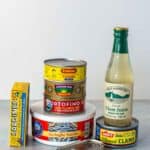Italian Dried Nuts and Fruits
Dried fruits, called frutta secca in Italian, and nuts are very commonly used in Italian cooking. From Sicilian almonds and pistachios, to Apulian dried figs and Campania's dried apricots, these ingredients add depth, sweetness and texture to Italian cuisine.
This post may contain affiliate links.

Dried nuts and fruits are an important pantry staple in Italy. Italians love them for their versatility, and long shelf life, plus they're a great healthy snack! They're very much used in both everyday meals and special occasions, adding unique flavors and textures to traditional dishes.
What sets Italian dried nuts and fruits apart from others is their high quality and taste, thanks to Italy's ideal growing conditions and traditional cultivation methods. Authentic Italian dried nuts and fruits are typically grown in specific regions.
For example, Sicilian almonds and pistachios are renowned worldwide for their superior quality. The rich soil, and mild climate, give Italian frutta secca a stronger and more aromatic flavor compared to others.
History and Culture
Italy's climate and fertile soil make an ideal location for cultivating a variety of fruits and nuts, especially in Southern Italy where they cultivate 90% of Italian's fruits and nuts.
The tradition of drying fruits and nuts dates back to ancient times, when people sought ways to preserve food for longer periods. The Romans, for example, were known to enjoy dried figs and walnuts, which they used in various dishes and as portable snacks during their conquests.
Over the centuries, the techniques for drying and storing these products have evolved, but the appreciation for their taste remains unchanged.
Types of Dried Nuts
- Almonds: Mandorle, Italian almonds, particularly those from Sicily, have a sweet flavor and slightly chewy texture. They are often used in desserts like biscotti, marzipan, and almond cakes. In Italy, you can find mandorle dolci and mandorle amare (sweet and bitter), but only the sweet ones are really almonds. Mandorle amare (bitter almonds), used in some cookies like amaretti, come from the apricot's pit and can be dangerous in large portions.
- Hazelnuts: Grown mainly in the Piedmont region, nocciole, Italian hazelnuts, have a rich, buttery taste. They are a key ingredient in the famous chocolate-hazelnut cream, Nutella, and the delicious gianduja chocolate.
- Walnuts: Italian walnuts, called noci, have a mild and slightly sweet flavor, and are perfect for both sweet and savory dishes. They are often used in pesto sauces or as toppings for salads.
- Pistachios: Sicilian pistachios from Bronte, are famous for their vibrant green color and intense flavor. They are used in a variety of sweet dishes, from pastries to gelato, especially in the form of luscious pistachio cream. In savory dishes, they're often salted and used with seafood, or cheese.
- Pine Nuts: Pinoli in Italian or Pignoli as they're known in the Italian-American community, they're mostly cultivated on the Italian west coast, where pine trees grow abundant right near the sea. They're used in both sweet and savory dishes, like basil pesto or pignoli cookies.
Types of Dried Fruits
- Figs: Dried figs are one of Italy's oldest dried fruits, with a sweet and slightly chewy texture. They are often enjoyed as snacks or used in baking.
- Apricots: Italian dried apricots are loved for their tangy-sweet taste and soft texture. They are commonly used in cakes, breads, and savory dishes.
- Raisins: Made from sun-dried grapes, Italian raisins are a staple in many traditional desserts, such as panettone and strudel.
- Prunes: Dried plums, or prunes, are known for their deep, sweet flavor and are often used in both sweet and savory dishes, including stews and cakes.
Quality and Authenticity
In Italy, certification marks like DOP (Denominazione di Origine Protetta) and IGP (Indicazione Geografica Protetta) are essential for ensuring the quality and authenticity of dried nuts and fruits. DOP, or Protected Designation of Origin, guarantees that the product is from a specific region using traditional methods and ingredients unique to that area. IGP, or Protected Geographical Indication, is slightly less stringent than DOP but still signifies a high-quality product.
Tips for Recognizing Authentic Italian Frutta Secca
- Check for Certification Marks: Look for DOP, IGP, or other recognized certifications on the label. These marks are a reliable indicator of authenticity and quality.
- Check the Label: Look for labels that indicate the product's origin, such as "Made in Italy" or "Product of Italy."
- Inspect the Packaging: Authentic Italian products often come in packaging that highlights the region of origin and includes detailed information about the producer.
- Look for Certification: Products with certifications like organic or non-GMO are often of higher quality and more authentic.
Uses in Italian Cuisine
Italian dried nuts and fruits are incredibly versatile and used in a wide range of dishes:
- Desserts: Almonds and hazelnuts are very common in traditional Italian desserts like biscotti, pastries, and cakes. Dried fruits like figs and raisins are key ingredients in holiday treats like panettone and strudel.
- Savory Dishes: Walnuts and pistachios can add flavor and texture to pasta dishes and salads. Prunes are sometimes an ingredient in meat dishes to add a touch of sweetness.
- Snacks: Both nuts and dried fruits make for an easy and healthy snack, perfect for on-the-go or as part of a charcuterie board.
Here are some of my favorite recipes using Italian dried nuts and fruits:
- Meyer Lemon + Pistachio Sandwich Cookies
- Ricotta Gelato with Pistachio and Fig
- Apricot Pistachio Tart
- Chocolate Hazelnut Panna Cotta
- Savory Pear Galette with Goat Cheese and Walnuts
- Celery Root + Pear Salad with Walnuts + Manchego
- Italian Pignoli Cookies
- Pesto Genovese: Classic Basil Pesto
- Sicilian Pesto alla Trapanese with Almonds and Tomatoes
- Easy Cranberry Tart with Almond Frangipane
- Cinnamon Raisin Walnut No-Knead Bread
- Roasted Cauliflower with Breadcrumbs, Capers, Almonds + Raisins
Buying and Storing Tips
Buying Tips:
- Purchase from reputable stores or online retailers that specialize in Italian products.
- Choose products with minimal additives or preservatives.
- If possible, buy in bulk to save money and reduce packaging waste.
Storage Tips:
- Store dried nuts and fruits in a cool, dry place in airtight containers to maintain freshness.
- Keep them away from direct sunlight and heat sources.
- For longer shelf life, consider refrigerating or freezing nuts and dried fruits.
FAQ
Yes, they are rich in vitamins, minerals, and healthy fats. They provide a good source of energy and can be part of a balanced diet.
When stored properly in airtight containers, dried nuts and fruits can last for several months. Refrigerating or freezing them can extend their shelf life even further.
Italian dried nuts and fruits are often considered superior due to the country's ideal growing conditions and traditional farming methods. They are typically more flavorful and of higher quality.




